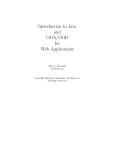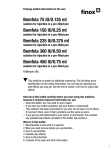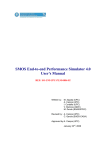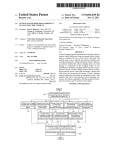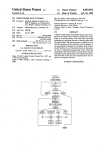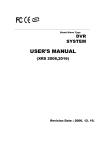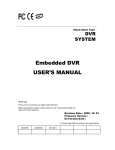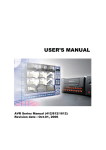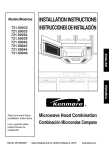Download Methods and systems for determining whether a voltage
Transcript
US 20140172332A1 (19) United States (12) Patent Application Publication (10) Pub. No.: US 2014/0172332 A1 (43) Pub. Date: Johnson et al. (54) METHODS AND SYSTEMS FOR Publication Classi?cation DETERMINING WHETHER A VOLTAGE MEASUREMENT IS USABLE FOR A STATE OF CHARGE ESTIMATION (51) (52) (71) Applicant: GM Global Technology Operations USPC Inventors: Kurt M. Johnson, Brighton, MI (US); (US); Brian J. Koch, Berkley, Ml (U S); Damon R. Frisch, Troy, MI (US); Patrick Frost, Novi, MI (US) 702/63 ABSTRACT Systems and methods for improvements in battery state of charge accuracy, charge termination consistency, capacity estimation, and energy delivery consistency. More speci? cally, embodiments herein detail systems and methods using (73) Assignee: GM Global Technology Operations an algorithm to calculate the change in state of charge for a LLC, Detroit, MI (U S) given voltage change (dSOC/dV) at a given temperature in a region around the present voltage measurement or estimation (21) Appl. No.: 13/717,958 Filed: (2006.01) .......................................................... .. (57) Brett B. StaWinski, Royal Oak, MI (22) Int. Cl. G01R 31/36 U.S. Cl. CPC .................................. .. G01R 31/362 (2013.01) LLC, Detroit, MI (U S) (72) Jun. 19, 2014 and to set a signal indicating When the measurement should not be used due to potential error. Dec. 18, 2012 100 104 | INTERFACE | / 215J MEMORY 220 PROCESSOR @ VEHICLE CONTROL MODULE 222 224 BATTERY CONTROL MODULE r216 INTERFACE 210 215 202 212 202 v 214 204 c 206 | T BATTERY PACK MODULE 1 MODULE ,252 CELLl , ' n fggoX CELLl 252/ I252 CELLO CELLO 252/ 192 Patent Application Publication Jun. 19, 2014 Sheet 1 0f 6 | INTERFACE US 2014/0172332 A1 | zTaJ MEMORY 220 PROCESSOR VEHICLE CONTROL MODULE m 222 22Ar BATTERY CONTROL MODULE r 216 INTERFACE | 202 205 204 206 \ \ \ \ BATTERY PACK MODULE 1 CW MODULE n ,252 fzzox . 252f [252 CELLL _ ' CELL n CELL n 252/ FIGT Patent Application Publication Jun. 19, 2014 Sheet 2 0f 6 US 2014/0172332 A1 Patent Application Publication a 2 Jun. 19, 2014 Sheet 3 0f 6 2 [AP / OOSP] HdO‘IS L" US 2014/0172332 A1 0 Patent Application Publication Jun. 19, 2014 Sheet 4 0f 6 US 2014/0172332 A1 100 20 22- 2624 28 30 l%] soc [AP / QOSP] HdO'IS FIG.4 Patent Application Publication START Jun. 19, 2014 Sheet 5 0f 6 US 2014/0172332 A1 I CREATE PRESENT SOC 7 BASED ON TEMPERATURE f AND VOLTAGE + OFFSET 15 H CALCULATE DIFFERENCE BETWEEN PREVIOUS SOC AND PRESENT SOC SET DO NOT USE FLAG LARGER THAN OLD 21 I H lNCREMENTi CREATE NEW OFFSET FIG. 5 STORE NEVV 153 DEEERENCE AS *" MAXIMUM DELTA Patent Application Publication Jun. 19, 2014 Sheet 6 0f 6 START 41 CREATE ARRAY P 45 | CALCULATE soc 45 CALCULATE dSOC |J 47 | DETERMINE MAXIMUM soc V49 | COMPARE T0 THRESHOLD V51 | OUTPUT END FIG. 6 P 55 55 US 2014/0172332 A1 Jun. 19, 2014 US 2014/0172332 A1 METHODS AND SYSTEMS FOR DETERMINING WHETHER A VOLTAGE MEASUREMENT IS USABLE FORA STATE OF CHARGE ESTIMATION tion. This method comprises providing at least one battery, at least one sensor coupled to said battery and at least one controller coupled to the at least one battery. The method additionally comprises sensing a temperature of the at least one battery with the at least one sensor, providing at least one FIELD [0001] The present invention relates generally to systems and methods for improvements in battery state of charge accuracy, charge termination consistency, capacity estima tion, and energy delivery consistency. More speci?cally embodiments herein detail an algorithm to calculate the change in state of charge for a given voltage change (dSOC/ dV) at a given temperature in a region around the present voltage measurement or estimation and to set a signal indi cating when the measurement should not be used due to potential error. BACKGROUND [0002] Knowing the state of charge of a battery is necessary for an indication of how much longer a battery will continue to perform prior to the need for either recharging or replace ment. As technologies related to vehicles continue to advance, the signi?cance of understanding and monitoring battery life becomes increasingly signi?cant. of the voltage measurement or the open-circuit voltage esti mation for the at least one battery, and starting an algorithm with the at least one controller. Speci?c embodiments of the algorithm involve creating an array of voltages from the pro vided voltage measurement or the open-circuit voltage esti mation, a step size, and a total number of elements, as well as calculating the state of charge (SOC) for each voltage in the array given the sensed temperature, and calculating the dif ference between each subsequent state of charge (dSOC) in the array. Speci?c embodiments of the algorithm also com prise determining the maximum dSOC from the array, deter mining if the maximum dSOC is above a threshold for usable data, and setting an output to “not use the data” when the maximum dSOC is above the threshold for usable data, or setting the output to “use the data” when the maximum dSOC is not above the threshold for usable data. [0008] Also provided herein are embodiments for novel systems for determining whether a voltage measurement or an open-circuit voltage estimation is usable for a state of charge estimation comprising at least one battery, at least one [0003] Battery charge can be measured through several methods, such as chemically, through measurements and plotting of curves related to discharge, or evenusing electrical the at least one sensor is con?gured to sense a temperature and modeling. provide the voltage measurement or the open-circuit voltage [0004] One known method of providing direct measure sensor coupled to said battery, and at least one controller coupled to the at least one battery. In speci?c embodiments estimation of the at least one battery, and the at least one ments is a method that converts a reading of the battery controller is con?gured to start an algorithm. More speci? voltage to state of charge (SOC), using the known discharge cally, in various embodiments, the controller is con?gured to curve (voltage versus SOC) of the battery. Using such a method SOC is graphed in relation to an open-circuit voltage provided voltage measurement or the open-circuit voltage (OCV) estimation which is the voltage at equilibrium and therefore current equals zero. With this method, however, the voltage reading is signi?cantly affected by the battery current start the algorithm so as to create an array of voltages from the estimation, a step size, and a total number of elements. The algorithm also can calculate the state of charge (SOC) for readings are made. Therefore such methods are often made each voltage in the array given the sensed temperature, cal culate the difference between each subsequent state of charge (dSOC) in the array, and determine the maximum dSOC from the array. This allows for the algorithm to determine if the more accurate by compensating the voltage reading with a correction term proportional to the battery current, and by maximum dSOC is above a threshold for usable data and set an output to “not use the data” when the maximum dSOC is using a look-up/reference table of the battery’s open-circuit above the threshold for usable data, or setting the output to “use the data” when the maximum dSOC is not above the threshold for usable data. due to the battery’s electrochemical kinetics as well as tem perature, especially if the battery is not truly at rest when voltage estimation versus temperature. [0005] In lithium iron phosphate batteries (LiFeP), regions of the SOC-OCV curve have large changes in SOC for small changes of OCV estimations. In these regions, voltage sens ing inaccuracies, analog-to-digital (A/D) resolution, and con BRIEF DESCRIPTION OF THE FIGURES troller area network (CAN) database resolution are some [0009] FIG. 1 is a schematic illustration of a system includ ing a battery pack and a controller such as a controller located potential causes of SOC inaccuracy. There is a need in the art within a vehicle. for systems and methods providing users with knowledge that [0010] FIG. 2 is a schematic illustration of Pack Voltage versus SOC percentage for a lithium iron phosphate battery. [0011] FIG. 3 is a schematic illustration of variance of the slope for one step size. [0012] FIG. 4 is a schematic illustration of variance of the an estimated SOC based on voltage in these regions may contain large errors and should not be used. [0006] Current systems are exceedingly complex, and there is a need in the art for increased simplicity, ef?ciency and decreased errors. Speci?c embodiments described herein lead to improvements in SOC accuracy, charge termination consistency, capacity estimation, and energy delivery consis tency. SUMMARY [0007] slope for a given step size with temperature. [0013] FIG. 5 is a ?ow diagram showing an algorithm for use with methods and systems described herein. [0014] FIG. 6 is a ?owchart for use with methods and systems described herein. DETAILED DESCRIPTION Embodiments of the present invention provide for determining whether a voltage measurement or an open-cir cuit voltage estimation is usable for a state of charge estima [0015] Speci?c embodiments of the present disclosure will now be described. The invention may, however, be embodied Jun. 19, 2014 US 2014/0172332 A1 in different forms and should not be construed as limited to 232 are connected together to provide cumulative power at the embodiments set forth herein. Rather, these embodiments are provided so that this disclosure will be thorough and complete, and will fully convey the scope of the invention to those skilled in the art. [0016] Unless otherwise de?ned, all technical and scien ti?c terms used herein have the same meaning as commonly understood by one of ordinary skill in the art to which this the module level of battery pack 102. invention belongs. The terminology used herein is for describing particular embodiments only and is not intended to be limiting of the invention. As used in the speci?cation and appended claims, the singular forms “a,” “an,” and “the” are [0025] Vehicle 100 is also shown to include a number of sensors connected to battery pack 102. Voltage sensors 202 measure the voltage of battery pack 102, modules 230, and/or cells 232 and provides voltage values to interface 216 of controller 104 via bus line 210. Current sensors 204 measure the current of battery pack 102, modules 230, and/ or cells 232 and provides current values to interface 216 of controller 104 via bus line 212. Temperature sensors 206 measures the tem perature of battery pack 102, modules 230, and/or cells 232 intended to include the plural forms as well, unless the con and provides temperature values to interface 216 of controller 104 via bus line 214. Sensors 202, 204, and 206 may be any text clearly indicates otherwise. number of sensors or con?gurations to measure the voltages, [0017] Unless otherwise indicated, all numbers expressing quantities of ingredients, properties such as molecular weight, reaction conditions, and so forth as used in the speci ?cation and claims are to be understood as being modi?ed in all instances by the term “about,” which is intended to mean up to 110% of an indicated value. Additionally, the disclosure of any ranges in the speci?cation and claims are to be under currents, and temperatures associated with battery pack 102. For example, temperature sensor 206 may be a single tem perature sensor, while voltage sensors 202 and current sen sors 204 may be a combined integrated circuit that measures both voltages and currents. It should be appreciated that any number of different combinations of sensors and sensor con ?gurations may be used, without deviating from the prin stood as including the range itself and also anything sub sumed therein, as well as endpoints. Unless otherwise indi ciples or teachings of the present disclosure. cated, the numerical properties set forth in the speci?cation memory 220, processor 219, vehicle control module, battery and claims are approximations that may vary depending on control module 224, and one or more interfaces (216, 218). In some embodiments, vehicle 100 may also include cell bal the desired properties sought to be obtained in embodiments of the present invention. Notwithstanding that numerical ranges and parameters setting forth the broad scope of the invention are approximations, the numerical values set forth in the speci?c examples are reported as precisely as possible. Any numerical values, however, inherently contain certain errors necessarily resulting from error found in their respec tive measurements. [0018] As used herein, the term “pack” is a combination of batteries/battery cells in series and parallel. [0019] As used herein “OCV” is an open-circuit voltage estimation of a battery cell or pack. OCV is equal to the measured voltage when the cell or pack is at equilibrium. [0020] As used herein, the term “signal” refers to a Boolean value or other designation, used in certain embodiments herein to designate whether an open-circuit voltage estima tion should be used. [0021] As used herein, the term “calculation device” refers to a computer or other device that can perform algorithms. [0022] In speci?c embodiments the new algorithm (see FIG. 5 and Example 1) tests the SOC-OCV curve at voltages [0026] The controller 104 can include an interface 218, ancing controller 208, which performs cell balancing on bat tery pack 102 in response to receiving a control command from controller 104 via bus line 213. In other embodiments, cell balancing controller 208 is omitted and controller 104 may provide control commands directly to battery pack 102 via bus line 213, to perform cell balancing. [0027] Still referring to controller 104, the controller 104 is shown to include processor 219, which may be one or more processors (e.g., a microprocessor, an application speci?c integrated circuit (ASIC), ?eld programmable gate array, or the like) communicatively coupled to memory 220 and inter faces 216 and 218. Memory 220 may be any form of memory capable of storing machine-executable instructions that implement one or more of the functions disclosed herein, when executed by processor 519. For example, memory 520 may be a RAM, ROM, ?ash memory, hard drive, EEPROM, CD-ROM, DVD, other forms of non-transitory memory devices, or any combination of different memory devices. In some embodiments, memory 220 includes vehicle control module 222, which provides control over one or more com ponents of vehicle 100. For example, vehicle control module near the measurement and at the same temperature to deter 222 may provide control over the engine of vehicle 100 or mine the difference in SOC between these points. A small difference in SOC indicates that the error introduced by the measurement is likely small and should be trusted. provide status condition information (e.g., vehicle 100 is low [0023] In speci?c embodiments of the invention, the present temperature of the battery is tested via one or more sensors also coupled to the controller so as to communicate information between parts of the system. By testing at the present temperature of the battery, the new algorithm can create the use/do not use signal at a higher resolution than could be performed with current methods. [0024] FIG. 1 illustrates a system including a battery pack and a controller 104 located within a vehicle. A vehicle 100 is shown, according to an exemplary embodiment. Battery pack on fuel, vehicle 100 has an estimated number of miles left to travel based on the present SOC of battery pack 102, etc.) to one or more display devices in the interior of vehicle 100 via interface 218. In some embodiments, vehicle control module 222 may also communicate with other processing circuits (e.g., an engine control unit, an on-board diagnostics system, or the like) or other sensors (e.g., a mass air?ow sensor, a crankshaft position sensor, or the like) via interface 218. [0028] In speci?c embodiments the controller 104 is located in different places in different applications, including in a car, such as in the passenger cabin and/or under seats and/or in a trunk. The controller 104 also can be located in a 102 includes modules 230, which provide cumulative electri laboratory used herein to refer to a building or location uti cal power to propel vehicle 100. Each of modules 230 con lized for testing equipment or performing other research or tains a plurality of battery cells 232. Similarly, battery cells where manufacturing is performed. A signal of “use the data” Jun. 19, 2014 US 2014/0172332 A1 or “not use the data” of a voltage measurement for SOC estimation as described herein can be automatically displayed on a car dash or other display for a user. [0029] FIG. 2 shows a schematic illustration of Pack Volt age versus SOC percentage for a lithium iron phosphate bat tery. As can clearly be seen, FIG. 2 shows very large regions of SOC percentage changes with little change in voltage (SOC percentage of 40-60%, 70-95%). This graph shows that a change in voltage correlates very well for a change in SOC percentage when the line slope is steep, and very poorly when the line is ?at (slope of nearly zero). For example, when the voltage changes from about 377 volts to about 375 volts, SOC percentage drops from only from about 100 to about 98 per cent SOC. However as the voltage drops from about 375 volts to about 373 volts, the SOC percentage drops from about 98 to about 71. Therefore a given voltage reading or even a measure of a voltage change in the ?at regions of the graph would not be an accurate way to calculate the change in state of charge. Embodiments herein described provide for a deter mination of when such data should be used and when it should not be used. [0030] FIG. 3 is a schematic illustration of variance of the slope for one step size. This graph shows that as the SOC percentage falls from 100 to 0, the dSOC/dV can either be approximately ?at (at near full charge or at very low charges) or can be very steep (at about 40-60 percent and at 70-95 percent). When the slope of the line this graph is steep, a given voltage measurement or measurement of voltage change would run the risk of being a poor estimate of a change in a SOC as the SOC is changing so rapidly around this voltage point. Therefore embodiments herein described account for this variability by accounting for the slope changes, and by estimating SOC using voltages higher and lower than the measurement using voltage steps. [0031] FIG. 4 is a schematic illustration of variance of the slope for a given step size with temperature. In the same way that FIG. 3 showed 1 step size, this graph shows multiple step sizes, from 90 to 100 percent (unlike FIG. 3 which showed form 0 to 100 percent). FIG. 4 shows more than one step size and indicates temperature signi?cance with measurements. FIG. 4 shows that temperature must be closely accounted for to determine accurate measurements. In the method being disclosed, the slope of the 20 degree Celsius dSOC/dV curve remains larger than the 30 degree Celsius dSOC/dV curve at higher states of charge. In prior art, temperatures between 20 iteration number. “NumStep” is a calibratable number of iterations to perform. “SOC” is state of charge. Offset is an addition or subtraction of a value (a correction term) and can be calculated or determined using one or more reference tables; when a voltage measurement is performed when a battery is not in equilibrium, then an offset value can be added or subtracted to correct the value, thereby providing an esti mation. The algorithm can utilize an offset to make correc tions to add or subtract values for more accurate determina tions, such as creating SOC estimations; the values can be obtained from reference charts accessible by one or more computers running the algorithm or in communication with the controller 104 that can run the algorithm, or the values can be predetermined. [0034] The FIG. 5 ?owchart steps include as follows: Start 1, ask “Is “i” less than NumStep” 3, if “Yes” 5 create present SOC based on temperature and voltage plus offset (if required) 7, ask “Does “i” equal zero?” 9, if “No” 11 calculate the difference between previous SOC and present SOC 13; ask “Is the new difference larger than the old difference?” 15 and if “Yes” 17 then store the new difference as maximum delta 19 before the step of “Increment I, create new offset” 21. If the new difference is not larger than the old difference (“No” 23) then go directly to 21 (also go directly to 21 if the answer to 9 is “Yes” 39). After 21, repeat step 3 (Is “i” less than NumStep). The other side of the ?owchart answers “No” 25 to the question ofIs “i” less than Numstep 3. If“No” 25, then ask “Is the maximum delta greater than cal?” 27. If “No” 29 then set use ?ag 31 (output of “use the data”). If “Yes” 33 then set the do not use ?ag 35 (output of “not use the data”). Then the end of steps 37 is reached. [0035] FIG. 6 is a schematic illustration of an embodiment showing a ?owchart for use with methods and systems described herein. The chart shows that embodiments of meth ods and systems described herein can include the aforemen tioned controller 104 and an algorithm, where the controller 104 can start the algorithm so as to: create an array of voltages from the provided voltage measurement or the open-circuit voltage estimation, a step size, and a total number of ele ments; calculate the SOC for each voltage in the array given the sensed temperature; calculate the difference between each dSOC in the array; determine the maximum dSOC from the array; determine if the maximum dSOC is above a threshold and 30 degrees Celsius could be evaluated as equivalent resulting in the rejection of state of charge estimates with low error at higher temperatures. [0032] Still regarding FIG. 4, FIG. 4 illustrates that it would for usable data; and to set an output to “not use the data” when the maximum dSOC is above a threshold for usable data, or be appropriate to use the OCV at 94% SOC if the temperature is not above a threshold for usable data. The step size refers to was greater than 26 degrees Celsius, but that a change in temperature could lead to signi?cant error. As shown, as the difference between array points for SOC determinations, much as 15% SOC error could be introduced if the tempera ture was only 20 degrees Celsius. Likewise, given a tempera ture of 20 degrees Celsius, the OCV would have to show about 97 percent before it would have less than 2 percent error based on the curve. [0033] FIG. 5 is a schematic illustration of an embodiment showing an algorithm for use with methods and systems described herein. The algorithm runs when a determination of a battery charge is required, which can be at times automati cally determined or pre-programmed into the controller 104 or an associated computer or computer system, or can be manually started. In the chart of the algorithm provided, “i” is setting the output to “use the data” when the maximum dSOC and can be any level automatically or manually determined and selected, such as between 0.001 volts to about 0.5 volts. Regarding the elements, the number of iterations is the num ber of elements in the array minus 1. Several algorithm itera tions are conceived, such as from about 1 to about 10 or about 10 to about 20, about 20 to about 50 or more. Thresholds can be based on calculated or predetermined data or both, and can be set automatically or via user manual input, and can be set to account for errors of any level, including such as error percentages of 1-5 percent, or 5-20 percent, or 20-30 percent or more. The thresholds can also be based in part or in whole on comparison of line slopes such as those shown in FIG. 3 and/or FIG. 4. Jun. 19, 2014 US 2014/0172332 A1 [0036] The speci?c steps of FIG. 6 are start 41, create array 43, calculate SOC 45, calculate dSOC 47, determine maxi mum SOC 49, compare to threshold 51, output 53, and end 55. [0037] The systems described herein such as controller 104 can be utilized in conjunction with computers and computer based systems. As will be appreciated by those skilled in the Example 1 [0043] An algorithm as shown in FIG. 5 outlines speci?c embodiments of the current invention. Steps of the embodi ments are shown below: (1) Algorithm start. This is a call of the function. The call occurs when a voltage needs to be evaluated. This voltage can be measured or estimated (2). If the number of steps is less than a calibration, proceed, other art, the embodiments can be utilized with a data processing or wise skip to step (7). Step (3): Use the voltage and measured computer system in general, and a digital computer in par ticular, preferably include an input, an output, a processing temperature to estimate a state of charge (SOC). Step (4): If this is the ?rst time through the loop, proceed to step (6), else unit (often referred to as a central processing unit (CPU)) and proceed to step (5). Step (5): Calculate the change between memory that can temporarily or permanently store such a conveyed to another program or a user via output. In one the previously calculated SOC and the presently calculated SOC. If this change is the largest change since the algorithm started in step 1, store this change as the maximum change. Step (6): Increment the number of steps and return to step (2). Step (7): Once all of the steps have been calculated and the maximum change in SOC has been determined, compare the form, a data-containing portion of the memory (also called maximum change in SOC to a calibration (8); If this calibra working memory) is referred to as random access memory tion is less than the maximum change in SOC, the algorithm output that is used to signal the quality of the voltage mea code, program or algorithm in the computer’s memory such that the instructions contained in the code are operated upon by the processing unit based on input data such that output data generated by the code and the processing unit can be (RAM), while an instruction-containing portion of the memory (also called permanent memory is referred to as read only memory (ROM). A data bus or related set of wires and associated circuitry forms a suitable data communication path that can interconnect the input, output, CPU and memory, as well as any peripheral equipment in such a way as surement or estimation is set to “not use the data,” otherwise, the output is set to “use the data.” Step (9): Algorithm end. The number of iterations is recommended to be odd, with the center value of voltage in the array equal to the voltage from step 1. to permit the system to operate as an integrated whole. Such [0044] a computer system is referred to as having a von Neumann architecture (also referred to as a general purpose or stored temperature of 25 degrees Celsius is sensed, with the voltage to be analyzed being 3.7 V, the number of steps 5, and the pro gram computer). voltage step size (dV) being 0.01 volts (this value is in speci?c [0038] embodiments set based on Max change in SOC:1%). Mul tiple iterations of speci?c embodiments are shown as follows: In speci?c embodiments herein described when a threshold is exceeded, the controller 104 or a computer or computer part can communicate the signal “not use the data” to a user via a signal light such as a signal light associated with a vehicle; a signal can also be communicated to a device to display the output. [0039] In speci?c embodiments described herein, the algo rithm uses an SOC-OCV look-up table that varies with tem An example of iterations is described as follows: a Iteration l:V:3.68 V, SOC:50%; Iteration 2:V:3.69 V, SOC:50.8%, dSOC:0.8%, maximum dSOC:0.8%; Itera tion 3:V:3.7 V, SOC:51.5%, dSOC:0.7%, maximum dSOC:0.8%; Iteration 4:V:3.7l V, SOC:52.6%, dSOCII. 1%, maximum dSOC:l .l%; Iteration 5:V:3.72V, SOC:52. 9%, dSOC:0.3%, maximum dSOC:l .l%; Regarding algo perature. [0040] In speci?c embodiments described herein, the algo rithm output (DataQuality), this can be set to “Do Not Use” because l.l%>l%. rithm takes into account rounding errors when determining error levels and threshold levels, where the rounding errors and systems can include one or more of: at least one battery details have been shown for purposes of illustrating the inven tion, it will be apparent to those skilled in the art that various changes may be made without departing from the scope of the invention, which is de?ned in the appended claims. 1. A method for determining whether a voltage measure that is a lithium-iron-pho sphate battery or a battery pack from ment or an open-circuit voltage estimation is usable for a state about 1 to about 10 batteries or from about 10 to about 20 batteries; a controller that can be located within a vehicle such of charge estimation, the method comprising: relate to A/D and/or CAN BUS. [0041] In speci?c embodiments herein described, methods [0045] While certain representative embodiments and calculation device for running the algorithm; a step size from providing at least one battery, at least one sensor coupled to said battery and at least one controller coupled to the at least one battery; sensing a temperature of the at least one battery with the at about 0.5 volts to about 0.1 volts or from about 0.1 volts to 0.01 about volts or from about 0.01 volts to 0.001 about volts; providing at least one of the voltage measurement or the as in a trunk or in a passenger cabin, or under a car seat; a controller that is located in a laboratory and coupled to a least one sensor; at least one sensor that can be one, two, or three sensors or open-circuit voltage estimation for the at least one bat more; sensors con?gured to measure temperature differences t8W; between about 1 and about 0.1 degree Celsius or between about 0.1 and about 0.01 degree Celsius, or between about starting an algorithm with the at least one controller wherein the algorithm comprises: 0.01 and about 0.001 degree Celsius. creating an array of voltages from the provided voltage EXAMPLES measurement or the open-circuit voltage estimation, a step size, and a total number of elements; [0042] The present invention will be better understood by reference to the following example which is offered by way of illustration not limitation. calculating the state of charge (SOC) for each voltage in the array given the sensed temperature; calculating the difference between each sub sequent state of charge (dSOC) in the array; Jun. 19, 2014 US 2014/0172332 A1 determining the maximum dSOC from the array; determining if the maximum dSOC is above a threshold for usable data; and setting an output to “not use the data” when the maxi mum dSOC is above the threshold for usable data, or setting the output to “use the data” when the maxi mum dSOC is not above the threshold for usable data. 2. The method of claim 1 wherein the at least one battery is a lithium-iron-pho sphate battery. 3. The method of claim 1 wherein the at least one battery is a battery pack. 4. The method of claim 1 wherein the at least one battery is a battery pack comprising about 1 to about 10 batteries. 5. The method of claim 1 wherein the at least one battery is a battery pack comprising about 10 to about 20 batteries. 6. The method of claim 1 wherein the at least one controller is a located within a vehicle. 7. The method of claim 1 wherein the at least one controller is located at least one of in a trunk of a car, in a passenger cabin of the car or under a seat of the car. 8. The method of claim 1 wherein the at least one controller is located in a laboratory and coupled to a calculation device for running the algorithm. 9. The method of claim 1 wherein the step size is from about 0.5 volts to about 0.1 volts. 10. The method of claim 1 wherein the step size is from about 0.1 volts to about 0.01 volts. 11. The method of claim 1 wherein the step size is from about 0.01 volts to about 0.001 volts. 12. The method of claim 1 wherein the at least one sensor 15. The method of claim 1 wherein the at least one sensor is con?gured to measure temperature differences between about 0.1 and about 0.01 degree Celsius. 16. The method of claim 1 wherein the at least one sensor is con?gured to measure temperature differences between about 0.01 and about 0.001 degree Celsius. 17. A system for determining whether a voltage measure ment or an open-circuit voltage estimation is usable for a state of charge estimation comprising: at least one battery; at least one sensor coupled to said battery; and at least one controller coupled to the at least one battery, wherein the at least one sensor is con?gured to sense a temperature and provide the voltage measurement or the open-circuit voltage estimation of the at least one bat tery, and the at least one controller is con?gured to start an algorithm so as to: create an array of voltages from the provided voltage measurement or the open-circuit voltage estimation, a step size, and a total number of elements; calculate the state of charge (SOC) for each voltage in the array given the sensed temperature; calculate the difference between each subsequent state of charge (dSOC) in the array; determine the maximum dSOC from the array; determine if the maximum dSOC is above a threshold for usable data; and set an output to “not use the data” when the maximum dSOC is above the threshold for usable data, or setting the output to “use the data” when the maximum dSOC is not above the threshold for usable data. 18. The system of claim 17 wherein the at least one battery is at least two sensors. is a lithium-iron-phosphate battery. 13. The method of claim 1 wherein the at least one sensor is at least three sensors. 14. The method of claim 1 wherein the at least one sensor is a battery pack. is con?gured to measure temperature differences between about 1 and about 0.1 degree Celsius. 19. The system of claim 17 wherein the at least one battery 20. The system of claim 17 wherein the at least one battery is a battery pack of from about 1 to about 10 batteries. * * * * *













